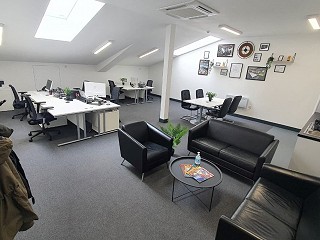Making the Most of Small Office Spaces: A Guide to Efficient Design
In today’s fast-paced and competitive business environment, small office spaces have become the norm for many professionals and entrepreneurs. However, working in a limited area can present unique challenges when it comes to productivity, organization, and overall efficiency. That’s why it’s crucial to make the most of every square inch available.
This blog aims to provide a comprehensive guide to efficient design in small office spaces. We will explore various strategies and techniques to optimize your workspace, maximize productivity, and create a functional environment that supports your business goals. By implementing these ideas, you can transform your compact office into a productive and inspiring space.
Assessing Your Needs and Setting Goals
Before diving into the design and layout of your small office space, it’s essential to assess your specific needs and set clear goals. By understanding the purpose of your office and the requirements of your work, you can tailor the design to suit your unique needs. Here are some key steps to consider:
A. Identifying the purpose and requirements of the office space
Determine the primary function of your office (e.g., creative work, client meetings, administrative tasks). Consider the specific equipment, tools, and materials you need to perform your work efficiently. Evaluate any specific spatial requirements based on your industry or profession (e.g., storage for inventory, space for equipment).
B. Analyzing workflow and daily activities
Map out your typical workflow and identify areas where bottlenecks or inefficiencies occur. Consider the frequency and nature of client or team interactions and how they influence the office layout. Determine the need for privacy or designated spaces for focused work or meetings.
Space Optimization Strategies
When working with small office space, optimizing every square inch becomes crucial to ensure efficiency and functionality. Here are some effective strategies to make the most of your limited space:
Utilizing vertical space: Look beyond the floor area and take advantage of vertical space. Install wall-mounted shelves, storage cabinets, or floating desks to keep essential items within reach while freeing up valuable floor space. Use vertical file organizers to store documents and folders, and consider utilizing pegboards or hooks to hang frequently used tools or supplies.
Incorporating multifunctional furniture and flexible layouts: Choose furniture pieces that serve multiple purposes to maximize functionality. Opt for desks with built-in storage or foldable tables that can be easily tucked away when not in use. Consider modular or movable furniture that can adapt to different tasks and layouts, allowing you to reconfigure the space as needed.
Maximizing natural light and using mirrors: Natural light not only creates a pleasant working environment but also gives the illusion of a larger space. Position desks and workstations near windows to capitalize on natural lighting. Additionally, strategically place mirrors to reflect light and visually expand the space.
Implementing smart storage solutions: Clutter can quickly diminish the functionality of a small office. Invest in storage solutions that optimize space utilization. Use stackable bins, drawer organizers, and labelled containers to keep items neatly organized and easily accessible. Consider utilizing under-desk storage units or utilizing unused wall space for mounted storage options.
Enhancing Productivity and Focus
Incorporating colors, textures, and plants:
Choose a colour scheme that promotes productivity and focus. Consider using calming colours like blue or green for a tranquil atmosphere, or energizing colours like yellow or orange to stimulate creativity. Introduce textures and patterns through furniture, rugs, or wall coverings to add visual interest and create a dynamic workspace. Bring in plants or small indoor gardens to improve air quality, reduce stress, and increase productivity. Select low-maintenance plants that thrive indoors, such as succulents or peace lilies.
Managing noise levels and distractions:
Create a designated quiet zone within the office for tasks that require concentration. Use acoustic panels or sound-absorbing materials to minimize noise disruptions. Consider using noise-cancelling headphones or white noise machines to drown out external distractions and create a focused work environment. Establish guidelines or office policies to promote a quiet and respectful workspace, encouraging colleagues to minimize noise and disruptions.
Establishing a designated workspace for concentration and productivity:
Define a specific area or workstation dedicated to focused work. This space should be free from distractions and equipped with the necessary tools and resources. Ensure the workstation is ergonomically designed, with a comfortable chair, proper lighting, and an organized setup that supports efficient workflow. Encourage employees to respect each other’s designated work areas and create boundaries to minimize interruptions.
Conclusion
Designing an efficient and functional small office space is a crucial step towards maximizing productivity and creating a conducive work environment. By following the strategies outlined in this guide, you can transform your limited office area into a well-organized and optimized workspace.
Starting with a thorough assessment of your needs and setting clear goals allows you to tailor the design to suit your specific requirements. From there, implementing space optimization strategies such as utilizing vertical space, incorporating multifunctional furniture, and implementing smart storage solutions helps maximize the use of every inch.
